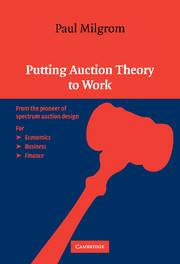7 - Uniform Price Auctions
Published online by Cambridge University Press: 05 June 2012
Summary
The resurgence of interest in auction theory owes much to recent large-scale auctions using designs suggested by economic theorists. From the spectrum auctions of 1994 onward, virtually all of these auctions have been uniform price auctions, in which auction rules either mandate equal prices for identical goods or encourage some sort of arbitrage, generating approximately uniform prices.
Many traditional auction designs fail to promote the law of one price, according to which identical goods have identical prices. One example is the first spectrum auction – Sotheby's 1981 auction of rights to use seven functionally identical transponders on a single RCA communications satellite. Sotheby's sold these rights using a sequence of seven auctions that produced seven different prices. The first transponder sold for $14.4 million and the prices of the second through sixth transponders successively declined. The sixth transponder sold for the lowest price, $10.7 million, and the seventh sold for $11.2 million. When an auctioneer sells several identical lots, bidders always have to guess about the prices of future lots, so some price variation is inevitable.
A striking aspect of the RCA transponder auction is the way prices declined from one item to the next. Ashenfelter (1989) has found that a similar pattern is common in auctions of wine and art, and this observation is now known as the declining price anomaly. Many have attempted to explain this anomaly. One possible explanation is that this pattern arises from a kind of selection bias akin to a winner's curse.
- Type
- Chapter
- Information
- Putting Auction Theory to Work , pp. 255 - 295Publisher: Cambridge University PressPrint publication year: 2004
References
- 2
- Cited by



